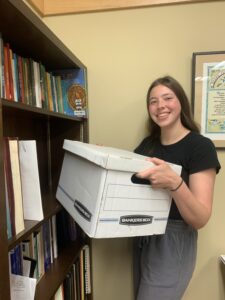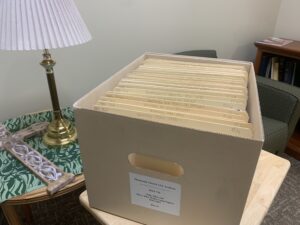Olivia Krall, archives coordinator for the MC USA Archives, provides helpful archival tips for those interested in preserving their family history.

Olivia Krall is the archives coordinator for MC USA. She strives to use the powerful history of the church to engage and inspire people. She graduated from Goshen College in 2023, with a Bachelor of Arts in history. Prior to joining the MC USA Executive Board staff, Olivia worked at the Elkhart County (Indiana) Historical Museum. Olivia attends Southside Fellowship, a congregation within the Central District Conference.
This article was first published in the MC USA Archives News, Vol. 2, Issue 3.
___________________________________________
Visitors to the MC USA Archives often ask, “How can I preserve my photos and documents?” Here are some helpful archival tips to preserve your family’s story for decades to come.
Environmental control: Keep your materials in a controlled environment that does not have large fluctuations in temperature or humidity. Heat and humidity speed up natural deterioration and increase the risk of threats, such as mold and pests. Avoid storing materials where there is the possibility of water damage or near food. If possible, keep the temperature below 75 degrees Fahrenheit and the relative humidity between 30-50%.
Document housing: For long-term preservation, acid-free folders and boxes are best. These items are available from suppliers such as Archival Methods or Gaylord Archival. If that is not possible, use file cabinets or clean cardboard boxes with lids that close. Make sure that storage containers are sturdy, do not give off a strong odor and were not previously used to hold food. Plastic totes are not recommended for long-term storage, as plastics can off-gas chemicals that are damaging to documents.
Preserving photos: Photographs are particularly sensitive, and it’s important to choose storage materials that will not speed up deterioration, such as photo sleeves or folders that have passed the Photographic Activity Test (PAT). Do not use adhesives, tape or metal fasteners that may discolor and damage photographs and documents. Place items into file folders within the containers for added protection.
 Cataloging: Keep track of your documents by labeling and making box lists. Label folders with a short description of the contents and the date the items were created. Label photographs by including a piece of paper with the image. Note in pencil who is in the photo and where and when it was taken. If that is not possible, label the photograph lightly in pencil on the back. A photo is most interesting to the next generation when they know who is in it!
Cataloging: Keep track of your documents by labeling and making box lists. Label folders with a short description of the contents and the date the items were created. Label photographs by including a piece of paper with the image. Note in pencil who is in the photo and where and when it was taken. If that is not possible, label the photograph lightly in pencil on the back. A photo is most interesting to the next generation when they know who is in it!
Make a box list that lists each folder inside a container in order. These are great for finding a specific file or item in a collection of multiple boxes and for identifying if anything has been misplaced or gone missing.
Look for more home archival tips in upcoming issues of the Archives News.
 Do you want to read more stories like this? Read the Archives News, the new quarterly newsletter from the MC USA Archives, here.
Do you want to read more stories like this? Read the Archives News, the new quarterly newsletter from the MC USA Archives, here.
The MC USA Archives seeks to inspire people worldwide to follow Jesus Christ by engaging them with the historical record of Mennonite Christian discipleship. Help the Archives continue to share stories like this one by donating here.
Bonus for Archives supporters: We are pleased to provide our Archives supporters with an exclusive printed copy of our quarterly newsletter.

